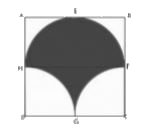PQRS is a square with side 10 cm. A, B, C and D are mid-points of PQ, QR, RS and SP respectively. Then the perimeter of the square ABCD so formed is
10√2cm
20√2cm
25√2cm
15√2cm
The correct Answer is:B
To find the perimeter of square ABCD formed by the midpoints of square PQRS, we can follow these steps:
Step 1: Identify the square PQRS
Given that PQRS is a square with each side measuring 10 cm, we can denote the vertices as follows:
- P(0, 0)
- Q(10, 0)
- R(10, 10)
- S(0, 10)
Step 2: Find the midpoints A, B, C, and D
The midpoints of the sides of the square PQRS are calculated as follows:
- A is the midpoint of PQ:
A=(0+102,0+02)=(5,0)
- B is the midpoint of QR:
B=(10+102,0+102)=(10,5)
- C is the midpoint of RS:
C=(10+02,10+102)=(5,10)
- D is the midpoint of SP:
D=(0+02,10+02)=(0,5)
Step 3: Calculate the length of side AD
To find the length of side AD, we can use the distance formula:
AD=√(5−0)2+(0−5)2=√52+(−5)2=√25+25=√50=5√2 cm
Step 4: Calculate the perimeter of square ABCD
Since ABCD is a square, all sides are equal. Therefore, the perimeter P of square ABCD can be calculated as:
P=4×side length=4×AD=4×5√2=20√2 cm
Final Answer
The perimeter of square ABCD is 20√2 cm.
---
Given that PQRS is a square with each side measuring 10 cm, we can denote the vertices as follows:
- P(0, 0)
- Q(10, 0)
- R(10, 10)
- S(0, 10)
The midpoints of the sides of the square PQRS are calculated as follows:
- A is the midpoint of PQ:
A=(0+102,0+02)=(5,0)
- B is the midpoint of QR:
B=(10+102,0+102)=(10,5)
- C is the midpoint of RS:
C=(10+02,10+102)=(5,10)
- D is the midpoint of SP:
D=(0+02,10+02)=(0,5)
To find the length of side AD, we can use the distance formula:
AD=√(5−0)2+(0−5)2=√52+(−5)2=√25+25=√50=5√2 cm
Since ABCD is a square, all sides are equal. Therefore, the perimeter P of square ABCD can be calculated as:
P=4×side length=4×AD=4×5√2=20√2 cm
The perimeter of square ABCD is 20√2 cm.
Topper's Solved these Questions
- MENSURATIONBOOK - KIRAN PUBLICATIONCHAPTER - MENSURATIONEXERCISE - TYPE -II
386 Videos
- MENSURATIONBOOK - KIRAN PUBLICATIONCHAPTER - MENSURATIONEXERCISE - TYPE - III
21 Videos
- LCM AND HCF BOOK - KIRAN PUBLICATIONCHAPTER - LCM AND HCF EXERCISE - Test Yourself
18 Videos
- MISCELLANEOUSBOOK - KIRAN PUBLICATIONCHAPTER - MISCELLANEOUSEXERCISE - TYPE-VI
15 Videos
Similar Questions
Knowledge Check
PQRSis a rectangle. Points A, B, C and D are the mid points of sides PQ,QR,RSandPSrespectively. If area of ΔPQR is 48cm2, then what is the area (in cm) of ΔBCD?
A24B6C16D12OPQR is a square with M and N as the middle points of the sides PQ and QR, respectively. The ratio of the areas of the square and the triangle OMN is
A4:1B2:1C8:3D4:3PQRS is a rectangle, A, B, C and D are the mid points of sides PQ, QR, RS and PS respectively. If area of ΔPQR is 48 cm2, then what is the area (in cm2) of ΔBCD?
A24B6C16D12
In the figure given below, ABCD is a square of side 14 cm with E, F, G and H as the mid points of sides AB, BC, CD and DA respectively. The area of the shaded portion is

View SolutionIf a,b∈N, PQRS is a square and P, Q, R, S are mid points of AB, AD, CD, BC respectively then a+b is
View Solutionfind (a) the area (b) the perimeter of the square PQRS, if the side is 20 cm.
View SolutionOPQR is a square with M and N as the middle points of the sides PQ and QR, respectively. The ratio of the areas of the square and the triangle OMN is
View SolutionLet □PQRS be a quadrilateral. If M and N are the mid-points of the sides PQ and RS respectively, then PS+QR=
View Solution
